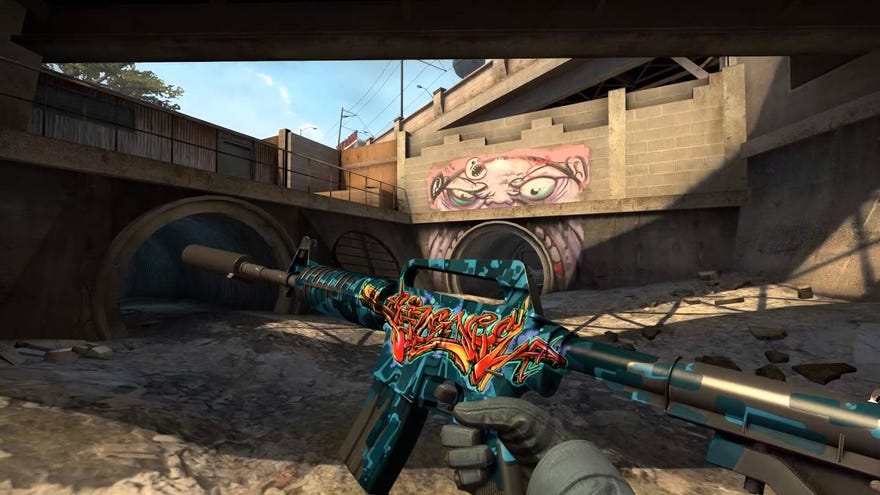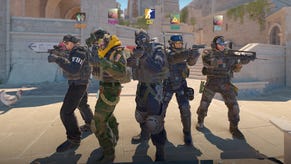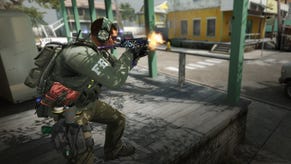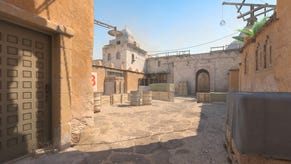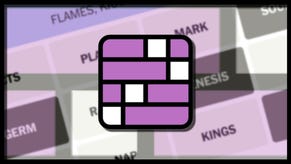CS:GO - Economy guide
Everything you need to know about money in CS:GO.
One of the terms you'll hear discussed a lot in the CS:GO scene surrounds the concept of “economy” - something that doesn't very intuitively explain itself.
To explain things simply, a team's economy is concerned with the amount of money that all players on the team have gathered collectively in order to buy new weapons and utilites.
This value is in a constant state of flux between rounds, and depends on how much the team has spent on weapons and armour, the kill awards that have been received per elimination (based on each weapon), the status of bomb planting / defusions, and who won the round in question.
All team members have their own pot of money that shifts and changes based on the events detailed above, and how you choose to manage your money has a significant impact on the rest of the team's purchasing plans.
For this reason you'll find that players will want to work together to purchase and swap items. If your AWP ace can't afford that weapon but you can, you can pick it up for them and swap with a gun that they can afford to purchase for you. It's just another side to the close teamwork and cooperation that's required to succeed in CS:GO.
Just keep in mind that there's a $16,000 cap for each individual player in Competitive matches, and $10,000 in its Casual counterpart.
In the rest of this article, we'll dig deeper into the concept of economy and help you understand how you can work it to the advantage of your team.
Round Outcomes
Until recently, the beginning of a Competitive match in CS:GO largely rested on the outcome of the pistol round, which takes place at the beginning of each half (rounds one and sixteen). The pistol round previously put the winning team at a much higher advantage in subsequent rounds, compared to the losing team, who then had to work significantly harder in order to catch up.
Valve has now adjusted the start-of-half economy to lessen the impact of the pistol round on the rest of the half by placing both sides on a one-round ‘loss streak’. This simply means that the losing side starts the second round with $1900 (previously $1400), then if they also lose the second round, they’ll receive $2400 as part of the ‘streak’.
This increases respectively and caps at a five-round loss streak. Bearing in mind that both sides start with pistols and $800, this gives everyone a solid chance at the beginning of the match, diminishing the destruction of the losing team’s economy early on, which was often worsened by tactical Anti-Ecos in the second round.
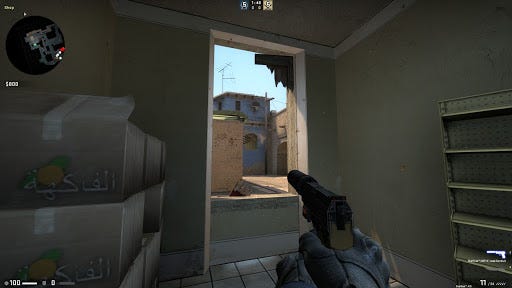
As we mentioned earlier, a number of monetary rewards are dished out following the outcomes and actions performed in a round.
Winning a round (by eliminating the entire team) provides the winning team with $3250 per player, plus $300 if the bomb is planted by a T. Winning by time on CT-side rewards players $3250, and winning the round with a defusal (CT) or detonation (T) of the bomb rewards $3500.
However, if the Ts run out of time before eliminating the entire CT-side or planting the bomb, they will not receive any rewards. If a round is lost on the T-side, but they still manage to plant the bomb, the team will be awarded $800 in addition to the current round loss streak value.
If you prefer a video tutorial, the YouTube video we've embedded below does a great job of explaining the basics of managing your economy in CS:GO
Weapon Kill Awards
The ‘kill award’ that you receive for eliminating an enemy will depend on which weapon you are using at the time. See the list below for more details on the Competitive kill awards:
Weapon - Award Per Kill ($)
- Knife - $1500
- Pistol (excluding CZ75-Auto) - $300
- CZ75-Auto - $100
- SMG (excluding P90) - $600
- P90 - $300
- Shotgun - $900
- Assault Rifles & Auto Snipers - $300
- AWP - $100
- Grenade - $300
- Zeus x27 - $0
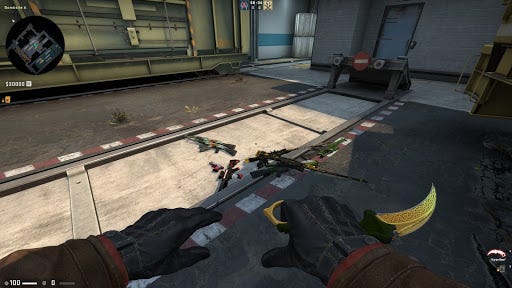
Being aware of how much each elimination will reward you with your chosen weapon will help you to understand how to manage your team’s economy.
For example, in a pistol round, it's common for each side to either keep their starter pistol or spend $300 on a P250, as it’s one of the cheaper pistols. With kill awards set to $300, it makes sense to start with a pistol that you’re comfortable you can score at least one elimination with, particularly if you purchase one.
For the same reason, try and avoid purchasing a Desert Eagle or CZ75-Auto in the first round as the Deagle costs $500, leaving you at a $200 deficit if you only eliminate one player, and as the CZ75-Auto only rewards $100 per elimination.
SMGs such as the MP7, UMP-45, MP9 and the Mac-10 all reward $600, which is a substantial reward, given their small price tags.
With the P90 being the only exception (granting just $300), using an SMG is a great way to build your team’s economy, putting you in a position to purchase assault rifles or potentially even an AWP early on in a match.
Confident players may also choose to reap the benefits of a shotgun to build up their economy quickly, with each kill awarding $900. Standing close to the entrance of a bombsite on CT-side with an XM1014, or jump-shooting with the MAG-7 could pay off if you’re able to secure a few eliminations by catching the enemy off-guard in a round.
Kill awards regarding the assault and sniper rifles are fair, resting at $300, with the only exception being the AWP, which only awards $100. In addition, grenade eliminations award the same amount as an assault rifle, sniper rifle or pistol, so be sure to purchase a HE Grenade whenever possible and learn how to finish off enemies with them.
More popular CS:GO guides:
- 1. Guide - CS:GO - Guide 2018
- 2. Best Weapons - CS:GO - Best weapons 2018
- 3. Recoil Control - CS:GO - Recoil control guide
- 4. Crosshairs - CS:GO - How to change crosshair
- 5. AWP - CS:GO - AWP guide 2018
The video we've embedded below does a great of explaining some of the common mistakes made by players with regards to economy, and we highly recommend watching the whole thing.
Managing Your Economy
Eco
An Eco-Round, otherwise known as a Save-Round or simply as an Eco, is a tactic used by teams to conserve as much money as possible for future rounds.
Typically you’ll want to do this when the overall economy of the team is low (less than $6000 altogether). With the new changes to the economy, Eco-Rounds don’t appear as often at the beginning of games now have more money to play around with.
Regardless, it’s important to know when the best time to hold off purchasing weapons to maximise your chances of winning in later rounds.
You should purchase very little during these rounds - mainly pistols and/or one or two grenades. Spending more than $1000 is more of a Force Buy tactic which can be disastrous if you lose, whereas losing an Eco-Round is almost expected.
That’s not to say you cannot win Ecos, but it’s important to understand your chances of winning during these rounds is significantly lower than usual.
There are many strategies you can employ in an Eco-Round, though the one you’ve most likely seen on T-side is the ‘Rush B’ plan. Again, you aren’t expected to win these rounds so it isn’t a terrible idea to try something unorthodox.
If the only thing you manage to do is plant the bomb during an Eco-Round, that’s still money in the bank to spend next round.
Anti-Eco
Anti-Eco rounds are used by teams that have recognised the opposition is about to perform an Eco-Round. The idea behind this is to shut down the enemy team by not only taking them down while they are unable to buy good weapons, but also to maximise the amount of money you are able to earn by purchasing weapons that grant high kill awards.
By completing a successful Anti-Eco round, the winning team can widen the economy gap, making it easier for them to win future rounds.
If you know the enemy team’s economy is so bad that they can only Eco, use this opportunity to purchase shotguns or SMGs (depending on the map you are playing). Without armour, these weapons are much more powerful compared to Full Buy rounds where both teams are equipped with the best gear available.
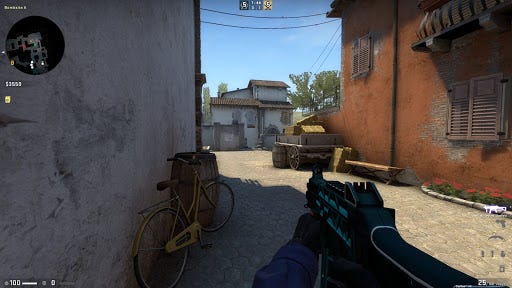
Force Buy
Force Buying (also referred to as a Half Buy) is a strategy which aims to utilise the team’s poor economy by purchasing inferior equipment to avoid Eco'ing in the next round.
This is certainly a risky strategy as a loss on a Force Buy round can destroy your economy, but the potential reward allows the Force Buying team to stabilise economy-wise.
Deciding whether or not to Force Buy depends largely on how badly you are losing compared to the enemy team. If the game is heading into the final rounds, a Force Buy round might be the gamble your team needs to seal the victory.
It’s not recommended to constantly Force Buy as your team will always be at a disadvantage against a team that has been Full Buying.
Full Buy
Full Buying is when a team’s economy is so strong that they are able to purchase all the items they need to maximise their chances of winning the round (armour, grenades and an assault rifle/sniper rifle).
For Ts, you are looking at spending roughly $4700, whereas CTs will have to fork out around $5500 as their weapons are more expensive and they will need a defuse kit to deactivate the bomb faster.
